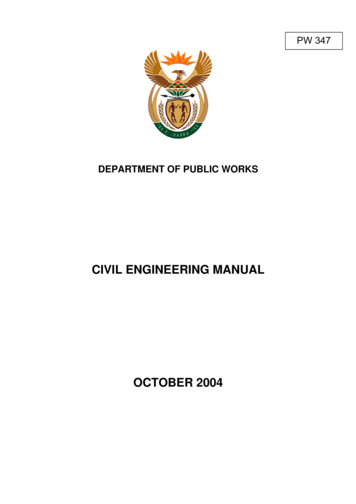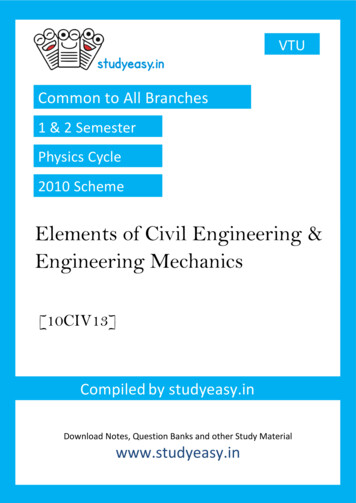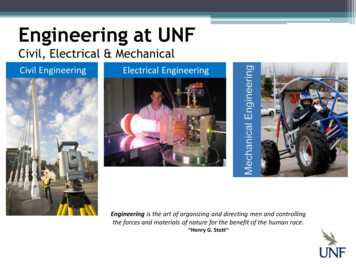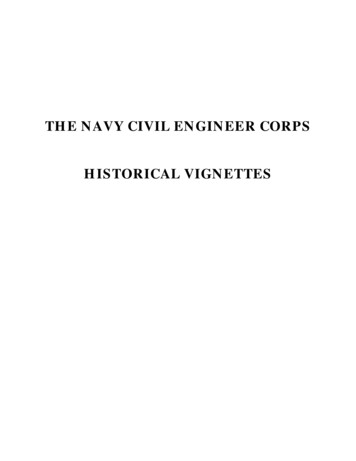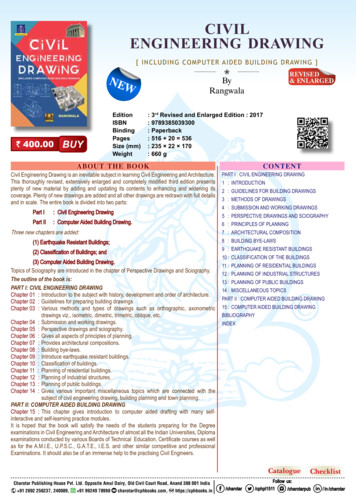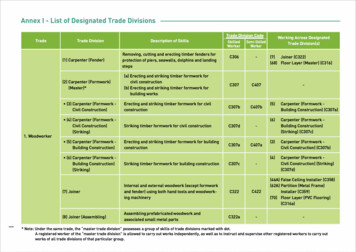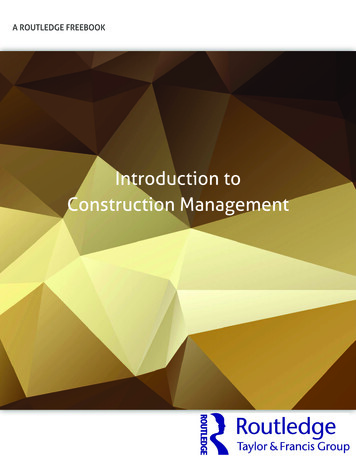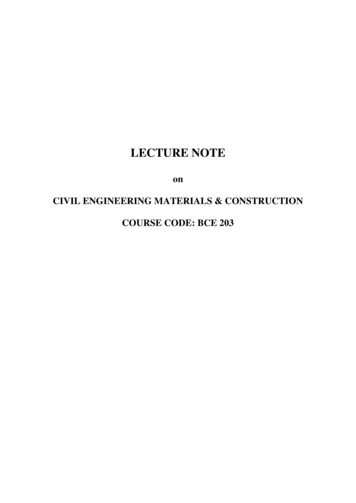
Transcription
LECTURE NOTEonCIVIL ENGINEERING MATERIALS & CONSTRUCTIONCOURSE CODE: BCE 203
SYLLABUSModule ChapterNumber Number1123Title2ArchesCavity WallStairsBrickCementConcreteTotal456Total3789Fire Resistive ConstructionPlasteringDamp preventionTotal410111213141516Types of doors and windowsPainting and decorationGlazingRepair of BuildingStoneTimberFoundationTotalTotal lecture hoursLecture hours(3-1-0)343103238222632221421640Text books1. A Text book of Building Construction, S.P. Arora and S.P. Bindra, Dhanpat Rai & Sons.Reference books1 A Text Book of Building Materials, C.J. Kulkarrni2 Building Materials, P. C. Varghese, PHI, Pvt. Ltd.3 Building Construction, P. C. Varghese, PHI, Pvt. Ltd.
1. BRICKConstituents of good brick earth:Bricks are the most commonly used construction material. Bricks are prepared by mouldingclay in rectangular blocks of uniform size and then drying and burning these blocks. In orderto get a good quality brick, the brick earth should contain the following constituents.oooooSilicaAluminaLimeIron oxideMagnesiaSilicaooooBrick earth should contain about 50 to % of silica.It is responsible for preventing cracking, shrinking and warping of raw bricks.It also affects the durability of bricks.If present in excess, then it destroys the cohesion between particles and the brickbecomes brittle.AluminaoooGood brick earth should contain about 20% to 30% of alumina.It is responsible for plasticity characteristic of earth, which is important in mouldingoperation.If present in excess, then the raw brick shrink and warp during drying.LimeooooThe percentage of lime should be in the range of 5% to 10% in a good brick earth.It prevents shrinkage of bricks on drying.It causes silica in clay to melt on burning and thus helps to bind it.Excess of lime causes the brick to melt and brick looses its shape.Iron oxideooooooA good brick earth should contain about 5% to 7% of iron oxide.It gives red colour to the bricks.It improves impermeability and durability.It gives strength and hardness.If present in excess, then the colour of brick becomes dark blue or blakish.If the quantity of iron oxide is comparatively less, the brick becomes yellowish incolour.1* Under revision
MagnesiaooooGood brick earth should contain less a small quantity of magnesia about1%)Magnesium in brick earth imparts yellow tint to the brick.It is responsible for reducing shrinkageExcess of magnesia leads to the decay of bricks.Harmful Ingredients in Brick:Below mentioned are some of the ingredients which are undesired in brick earth.LimeooA small quantity of lime is required in brick earth. But if present in excess, it causesthe brick to melt and hence brick looses its shape.If lime is present in the form of lumps, then it is converted into quick lime afterburning. This quick lime slakes and expands in presence of moisture, causing splittingof bricks into pieces.Iron pyritesoThe presence of iron pyrites in brick earth causes the brick to get crystallized anddisintegrated during burning, because of the oxidation of the iron pyrits.oPyrites discolourise the bricks.AlkalisooThese are exist in the brick earth in the form of soda and potash. It acts as a flux in thekiln during burning and it causes bricks to fuse, twist and warp. Because of this,bricks are melted and they loose their shape.The alkalis remaining in bricks will absorb moisture from the atmosphere, whenbricks are used in masonry. With the passage of time, the moisture gets evaporatedleaving grey or white deposits on the wall surface (known asefflorescence). Thiswhite patch affects the appearance of the building structure.PebblesooPebbles in brick earth create problem during mixing operation of earth. It preventsuniform and through mixing of clay, which results in weak and porous bricksBricks containing pebbles will not break into shapes as per requirements.Vegetation and Organic MatteroThe presence of vegetation and organic matter in brick earth assists in burning. But ifsuch matter is not completely burnt, the bricks become porous. This is due to the factthat the gasses will be evolved during the burning of the carbonaceous matter and itwill result in the formation of small pores.2* Under revision
Efflorescence in BrickStone in BrickManufacturing of bricksIn the process of manufacturing bricks, the following distinct operations are involved. Preparation of clayMouldingDryingBurningEach of the above operation of the manufacturing bricks will now be studied at length.Preparation of clayThe clay for brick is prepared in the following order. Unsoiling Digging Cleaning Weathering Blending TemperingUnsoiling: The top layer of the soil, about 200mm in depth, is taken out and thrown away.The clay in top soil is full of impurities and hence it is to be rejected for the purpose ofpreparing bricks.Digging: The clay is then dug out from the ground. It is spread on the levelled ground, just alittle deeper than the general level. The height of heaps of clay is about 600mm to 1200mm.Cleaning: The clay as obtained in the process of digging should be cleaned of stones,pebbles, vegetable matters. If these particles are in excess, the clay is to be washed andscreened. Such a process naturally will prove to be troublesome and expensive.3* Under revision
Weathering: The clay is then exposed to atmosphere for softening and mellowing. The periodvaries from few weeks to full season.Blending: The clay is made loose and any ingredient to be added to it , is spread out at its top.The blending indicates intimate or harmonious mixing. It is carried out by taking a smallamount of clay every time and turning it up and down in vertical direction. The blendingmakes clay fit for the next stage of tempering.Tempering: In the process of tempering, the clay is brought to a proper degree of hardnessand it is made fit for the next operation of moulding .Kneaded or pressed under the feet ofman or cattle .The tempering should be done exhaustively to obtain homogeneous mass ofclay of uniform character.For manufacturing good bricks on a large scale, tempering is donein pug mill.A typical pug mill capable of tempering sufficient earth for a daily output ofabout 15000 to20000 bricks.A pug mill consists of a conical iron tub with cover at its top .It is fixed on a timber basewhich is made by fixing two wooden planks at right angle to each other. The bottom of tub iscovered except for the hole to take out pugged earth. The diameter of pug mill at bottom isabout 800mm and that at top is about 1 m.The provision is made in top cover to place clayinside pug mill .A vertical shaft with horizontal arms is provided at center of iron tub.Thesmall wedge-shaped knives of steel are fixed at arms.The long arms are fixed at vertical shaftto attach a pair of bullocks .The ramp is provided to collect the pugged clay .The height ofpug mill is about 2m. Its depth below ground is 600m to800mm lessen the rise of the barrowrun and to throw out the tempered clay conveniently.In the beginning, the hole for puggedclay is closed and clay with water is placed in pug mill from the top. When vertical shaft isrotated by a pair of bullock, the clay is thoroughly mixed up by the action of horizontal armsand knives and homogeneous mass is formed.The rotation of vertical shaft can also be achieved by using steam, diesel or electricalpower.When clay has been sufficiently pugged, the hole at the bottom of the tub, is openedout and pugged earth is taken out from the ramp by barrow i.e. a small cart with wheels fornext operation of moulding.The pug mill is then kept moving and feeding of clay from topand taking out of pugged clay from bottom are done simultaneously.If tempering is properlycarried out, the good brick earth can then be rolled without breaking in small threads of 3mmdiameter.4* Under revision
Fig of a Pug millMoulding:The clay which is prepared as above is then sent for the text operation of moulding.Followingare two types of moulding:i.Hand Mouldingii.Machine MouldingHand moulding:In hand moulding , the bricks are moulded by hand i.e.; manually. It is adopted wheremanpower is cheap and is readily available for the manufacturing process of bricks ona smallscale.The moulds are rectangular boxes which are open at top and bottom.They may be ofwood or steel.It should be beprepared from well-seasonedwood. The longer sides are keptslightly projecting to serve as handles. The strips of brass or steel are sometimes fixed on theedges of wooden moulds to make them more durable.It is prepared from the combination ofsteel plate and channel. It may even be prepared from steel angles and plates. Thethickness ofsteel mould is 6mm.They is used for manufacturing bricks on alarge scale. The steel mouldsare more durable than wooden one and turn out bricks of uniform size.The bricks shrinkduring drying and burning .Hence the mouldsare therefore made larger than burnt bricks (812%).The bricks prepared by hand moulding are of two types: Ground mouldedand TablemouldedGround mouldedbricks: The ground is first made level and fine sand is sprinkled over it.Themould is dipped in water and placed over the ground. The lump of tempered clay is taken andis dashed is the mould.The clay is pressed in the mould in such a way that it fills all thecorners of mould.The surplus clay is removed by wooden strike or framed with wire. A strikeis a piece of wood or metal with a sharp edge.It is to be dipped in water every time.Themould is then lifted up and raw brick ids left on the ground.The mould is dipped in water andit is placed just near the previous brick to prepare another brick.The process is repeated tillthe ground is covered with raw bricks.The lower faces of ground moulded bricks are rough5* Under revision
and it is not possible to place frog on such bricks.A frog is mark of depth about 10mm to20mm which is placed on raw brick during moulding.It serves two purposes.1.It indicates the trade name of the manufacturer2.In brick work, the bricks are laid with frog uppermost. It thus affords a key for mortar whenthe next brick is placed over it.The ground moulded bricks of better quality and with frogs on their surface are made byusing a pair of pallet boards and a wooden block. A pallet is a piece of thin wood.The blockis bigger than the mould and it has projection of about 6mm height on its surface.Thedimensions of projection correspond to internal dimensions of mould.The design ofimpression or frog is made on this block.The wooden block is also known as the mouldingblock or stock board.The mould is placed to fit in the projection of wooden block and clay is then dashed insidethe mould.A pallet is placed on the top and the whole thing is then turn upside down.Themould is taken out and placed over the raw brick and it is conveyed to the drying sheds.Thebricks are placed to stand on their longer sides in drying sheds and pallet boards are broughtback for using them again.As the bricks are laid on edge, they occupyless space and they dryquicker and better.Table Moulded Bricks:i) The process of moulding of bricks is just similar as above.But in this case, the mouldstands near a table size 2m x 1m. The bricks are moulded on the table and send forfurther process of drying.ii) However the efficiency of the moulder gradually decreases because of standing atsome place for a longer duration.The cost of brick is also increases when table mouldingis adopted.Machine Moulding:This type of moulding is carried out by two processes:i)ii)Plastic clay machineDry clay machinePlastic Clay Mouldingi) Such machine consists of a rectangular opening having length and width is equal to anordinary bricks. The pugged clay is placed in the machine and it comes out through therectangular opening.ii) These are cut into strips by the wire fixed at the frame. The arrangement is made in such away that the strips thickness is equal to that of the bricks are obtained. So it is also called asWIRE CUT BRICKS.6* Under revision
Dry Clay Machinemoulding:In these machines, the strong clay is finally converted in to powered form.A small quantity ofwater is then added to form a stiff plastic paste.ii) Such paste is placed in mould and pressed by machine to form dry and well-shaped bricks.They do not require the process of drying.DryingThe damp bricks, if brunt,are likely to be cracked and distorted.Hence the moulded bricks aredried before they are taken for the next operation of burning. For the drying the bricks arelaid longitudinally in the stacks of width equal to two bricks,A stack consists of ten or eighttiers.The bricks are laid along and across the stock in alternate layers. All the bricks areplaced on edges. The bricks are allowed to dry until the bricks are become leather hard ofmoisture content about 2%.BurningBricks are burned at high temperature to gain the strength, durability, density and red colorappearance.All the water is removed at the temperature of 650 degrees but they are burnt atan temperature of about 1100 degrees because the fusing of sand and lime takes place at thistemperature and chemical bonding takes between these materials after the temperature iscooled down resulting in the hard and dense mass.Bricks are not burnt above this temperature because it will result in the melting of the bricksand will result in a distorted shape and a very hard mass when cooled which will not beworkable while brickwork. Bricks can be burnt using the following methods:(a) Clamp Burning(b) Kiln BurningClamp Burning:Clamp is a temporary structure generally constructed over the ground with a height of about 4to 6 m. It is employed when the demand of the bricks is lower scale and when it is not amonsoon season. This is generally trapezoidal in plan whose shorter edge among the parallelsides is below the ground and then the surface raising constantly at about 15 degrees to reachthe other parallel edge over the ground.A vertical brick and mud wall is constructed at thelower edge to support the stack of the brick. First layer of fuel is laid as the bottom most layerwith the coal, wood and other locally available material like cow dung and husk.Anotherlayer of about 4 to 5 rows of bricks is laid and then again a fuel layer is laid over it. Thethickness of the fuel layer goes on with the height of the clamp.7* Under revision
After these alternate layers of the bricks and fuel the top surface is covered with the mud soas to preserve the heat.Fire is ignited at the bottom, once fire is started it is kept under fire byitself for one or two months and same time period is needed for the cooling of the bricks.Disadvantages of Clamp burning:1.Bricks at the bottom are over-burnt while at the top are under-burnt.2.Bricks loose their shape, and reason may be their descending downward once the fuellayer is burnt.3.This method cannotemploy for the manufacturing of large number of bricks and it iscostly in terms of fuel because large amount of heat is wasted.4.It cannot be employed in monsoon season.Kiln Burning:Kiln is a large oven used for the burning of bricks. Generally coal and other locally availablematerials like wood, cow dung etc can be used as fuel. They are of two types: Intermittent Kilns.Continuous Kilns.Fig of a typical kiln8* Under revision
Intermittent Kilns: these are also the periodic kind of kilns, because in such kilns only oneprocess can take place at one time. Various major processes which takes place in the kilnsare:Loading, unloading, Cooling, and Burning of bricks.There are two kind of intermittent kilns:(i)(ii)Up-draught Intermittent KilnsDown draught Intermittent KilnsDown draught kilns are more efficient because the heat is utilized more by moving the hotgases in the larger area of the kiln. In up draught kilns the hot gases are released after theyrise up to chimney entrance.Continuous Kilns:These kilns are called continuous because all the processes of loading, unloading, cooling,heating, pre-heating take place simultaneously. They are used when the bricks are demandedin larger scale and in short time. Bricks burning are completed in one day, so it is a fastmethod of burning.There are two well-known continuous kilns:Bull's Trench Kiln:Bull's trench kiln consists of a rectangular, circular or oval plan shape.They are constructed below the ground level by excavating a trench of the required width forthe given capacity of brick manufacturing.This Trench is divided generally in 12 chambers sothat 2 numbers of cycles of brick burning can take place at the same time for the largerproduction of the bricks. Or it may happen that one cycle is carried out at one time in all the12 chambers by using a single process in the 2-3 chambers at the same time.The structure isunder-ground so the heat is conserved to a large extent so it is more efficient. Once fire isstarted it constantly travels from one chamber to the other chamber, while other operationslike loading, unloading, cooling, burning and preheating taking place simultaneously.Such kilns are generally constructed to have a manufacturing capacity of about 20,000 bricksper day. The drawback of this kiln is that there is not a permanent roof, so it is not easy tomanufacture the bricks in the monsoon seasons.Hoffman's Kiln:The main difference between the Bull's trench kiln and the Hoffman kilnsare:1. Hoffman's kiln is an over the ground structure while Bull's Trench Kiln is anunderground structure.2.Hoffman's kiln have a permanent roof while Bull's trench Kiln do not have so itformer can be used in 12 months a year to manufacture bricks but later is stopped in themonsoon season.Hoffman's kiln is generally circular in plan, and is constructed over the ground. The wholestructure is divided into the 12 chambers and the entire processes takes place simultaneouslylike in Bull's trench Kiln.9* Under revision
Classification of Bricks as per common practice:Bricks, which are used in construction works, are burnt bricks. They are classified into fourcategories on the basis of its manufacturing and preparation, as given below.1.2.3.4.First class bricksSecond class bricksThird class bricksFourth class bricksFirst Class Bricks:These bricks are table moulded and of standard shape and they are burnt in kilns. The surfaceand edges of the bricks are sharp, square, smooth and straight. They comply with all thequalities of good bricks. These bricks are used for superior work of permanent nature.Second Class Bricks:These bricks are ground moulded and they are burnt in kilns. The surface of these bricks issomewhat rough and shape is also slightly irregular. These bricks may have hair cracks andtheir edges may not be sharp and uniform. These bricks are commonly used at places wherebrick work is to be provided with a coat of plaster.Third Class Bricks:These bricks are ground moulded and they are burnt in clamps. These bricks are not hard andthey have rough surfaces with irregular and distorted edges. These bricks give dull soundwhen struck together. They are used for unimportant and temporary structures and at placeswhere rainfall is not heavy.Fourth Class Bricks:These are over burnt bricks with irregular shape and dark colour. These bricks are used asaggregate for concrete in foundations, floors, roads etc, because of the fact that the over burntbricks have a compact structure and hence they are sometimes found to be stronger than eventhe first class bricks.Classification of Bricks as per constituent materialsThere are various types of bricks used in masonry. Common Burnt Clay BricksSand Lime Bricks (Calcium Silicate Bricks)Engineering BricksConcrete BricksFly ash Clay Bricks10* Under revision
Common Burnt Clay BricksCommon burnt clay bricks are formed by pressing in moulds. Then these bricks are dried andfired in a kiln. Common burnt clay bricks are used in general work with no special attractiveappearances. When these bricks are used in walls, they require plastering or rendering.Sand Lime BricksSand lime bricks are made by mixing sand, fly ash and lime followed by a chemical processduring wet mixing. The mix is then moulded under pressure forming the brick. These brickscan offer advantages over clay bricks such as: their colour appearance is grey instead of theregular reddish colour.Their shape is uniform and presents a smoother finish that doesn’trequire plastering.These bricks offer excellent strength as a load-bearing member.Engineering BricksEngineering bricks are bricks manufactured at extremely high temperatures, forming a denseand strong brick, allowing the brick to limit strength and water absorption.Engineering bricksoffer excellent load bearing capacity damp-proof characteristics and chemical resistingproperties.Concrete BricksConcrete bricks are made from solid concrete. Concrete bricks are usually placed in facades,fences, and provide an excellent aesthetic presence. These bricks can be manufactured toprovide different colours as pigmented during its production.Fly Ash Clay BricksFly ash clay bricks are manufactured with clay and fly ash, at about 1,000 degrees C. Somestudies have shown that these bricks tend to fail poor produce pop-outs, when bricks comeinto contact with moisture and water, causing the bricks to expand.Tests on BricksTo know the quality of bricks following 7 tests can be performed. In these tests some areperformed in laboratory and the rest are on field.11* Under revision
Compressive strength test Water Absorption test Efflorescence test Hardness test Size, Shape and Colour test Soundness test Structure testCompressive strength test: This test is done to know the compressive strength of brick. It isalso called crushing strength of brick. Generally 5 specimens of bricks are taken to laboratoryfor testing and tested one by one. In this test a brick specimen is put on crushing machine andapplied pressure till it breaks. The ultimate pressure at which brick is crushed is taken intoaccount. All five brick specimens are tested one by one and average result is taken as brick’scompressive/crushing strength.Water Absorption test: In this test bricks are weighed in dry condition and let themimmersed in fresh water for 24 hours. After 24 hours of immersion those are taken out fromwater and wipe out with cloth. Then brick is weighed in wet condition. The differencebetween weights is the water absorbed by brick. The percentage of water absorption is thencalculated.The less water absorbed by brick the greater its quality. Good quality brickdoesn’tabsorb more than 20% water of its own weight.Efflorescence test: The presence of alkalies in bricks is harmful and they form a grey orwhite layer on brick surface by absorbing moisture. To find out the presence of alkalis inbricks this test is performed. In this test a brick is immersed in fresh water for 24 hours andthen it’s taken out from water and allowed to dry in shade.If the whitish layer is not visible onsurface it proofs that absence of alkalis in brick. If the whitish layer visible about 10% ofbrick surface then the presence of alkalis is in acceptable range. If that is about 50% ofsurface then it is moderate. If the alkalies’ presence is over 50% then the brick is severelyaffected by alkalies.Hardness test: In this test a scratch is made on brick surface with a hard thing. If that doesn’tleft any impression on brick then that is good quality brick.Size, shape and colour test: In this test randomly collected 20 bricks are staked alonglengthwise, width wise and height wise and then those are measured to know the variation ofsizes as per standard. Bricks are closely viewed to check if its edges are sharp and straight12* Under revision
and uniform in shape. A good quality brick should have bright and uniform colourthroughout.Soundness test: In this test two bricks are held by both hands and struck with one another. Ifthe bricks give clear metallic ringing sound and don’t break then those are good qualitybricks.Structure test: In this test a brick is broken or a broken brick is collected and closelyobserved. If there are any flows, cracks or holes present on that broken face then that isn’tgood quality brick.13* Under revision
2. CEMENTCement is a binder, a substance that sets and hardens and can bind other materials together.Cements used in construction can be characterized as being either hydraulic or non-hydraulic,depending upon the ability of the cement to be used in the presence of water.Non-hydrauliccement will not set in wet conditions or underwater, rather it sets as it dries and reacts withcarbon dioxide in the air. It can be attacked by some aggressive chemicals aftersetting.Hydraulic cement is made by replacing some of the cement in a mix with activatedaluminium silicates, pozzolanas, such as fly ash. The chemical reaction results in hydratesthat are not very water-soluble and so are quite durable in water and safe from chemicalattack. This allows setting in wet condition or underwater and further protects the hardenedmaterial from chemical attack (e.g., Portland cement).Use Cement mortar for Masonry work, plaster and pointing etc. s,beams,weather-shed,stairs,pillars etc. sbridge,culverts,dams,tunnels,light house,clocks,etc. Construction of water,wells, tennis courts,septic tanks, lamp posts, telephone cabinsetc. Making joint for joints,pipes,etc. Manufacturing of precast pipes,garden seats, artistically designed wens, flower posts,etc. Preparation of foundation, water tight floors, footpaths, etc.Types of CementsMany types of cements are available in markets with different compositions and for use indifferent environmental conditions and specialized applications. A list of some commonlyused cement is described in this section:14* Under revision
Ordinary Portland cementOrdinary Portland cement is the most common type of cement in general use around theworld. This cement is made by heating limestone (calcium carbonate) with small quantities ofother materials (such as clay) to 1450 C in a kiln, in a process known as calcination, wherebya molecule of carbon dioxide is liberated from the calcium carbonate to form calcium oxide,or quicklime, which is then blended with the other materials that have been included in themix. The resulting hard substance, called 'clinker', is then ground with a small amount ofgypsum into a powder to make 'Ordinary Portland Cement'(often referred to as OPC).Portland cement is a basic ingredient of concrete, mortar and most non-specialty grout. Themost common use for Portland cement is in the production of concrete. Concrete is acomposite material consisting of aggregate (gravel and sand), cement, and water. As aconstruction material, concrete can be cast in almost any shape desired, and once hardened,can become a structural (load bearing) element. Portland cement may be grey or white. This type of cement use in construction when there is no exposure to sulphates in thesoil or ground water.Lime saturation Factor is limited between i.e. 0.66 to 1.02.Free lime-cause the Cement to be unsound.Percentage of (AL 2 O 3 /Fe 2 O 3 ) is not less than 0.66.Insoluble residue not more than 1.5%.Percentage of SO 3 limited by 2.5% when C 3 A 7% and not more than 3% whenC 3 A 7%.Loss of ignition -4%(max)Percentage of Mg0-5% (max.)Fineness -not less than 2250 cm2/g.Rapid hardening Portland cement It is firmer than Ordinary Portland CementIt contains more C 3 S are less C 2 S than the ordinary Portland cement.Its 3 days strength is same as 7 days strength of ordinary Portland cement.Low heat Portland cement Heat generated in ordinary Portland cement at the end of 3days 80 cal/gm. While inlow heat cement it is about 50cal/gm of cement.It has low percentage of C3A and relatively more C 2 S and less C 3 S than O.P.Cement.Reduce and delay the heat of hydration. British standard ( B S. 1370 : 1974 ) limit theheat of hydration of this cement.Sulphate resisting Portland cement Maximum C3A content by 3.5% and minimum fineness by 2500 cm'/g.15* Under revision
Firmer than ordinary pot land cement.Sulphate forms the sulpha-aluminates which have expensive properties and so causesdisintegration of concrete.Sulphate resisting Portland cement For this cement, the silage as obtained from blast furnace is usedThe clinkers of cement are ground with about 60 to 65 percent of slag.Its strength in early days is less and hence it required longer curing period. It provesto be economical as slag, which is a Waste product, is used in its manufactures.Pozzolanic cement As per Indian standard, the proportions of Pozzolana may be 10 to 25 % by weight.e.2. Burnt clay, shale, Fly ash.This Cement has higher resistance to chemical agencies and to sea water because ofabsence of lime.It evolves less heat and initial strength is less but final strength is 28 days onwardequal to ordinary Portland cement.It possesses less resistance to the erosion and weathering action.It imparts higher degree of water tightness and it is cheap.White Portland cement Grey colour of O.P. cement is due to presence of Iron Oxide. Hence in White CementFe,,O, is limited to 1 %. Sodium Alumina Ferrite (Crinoline) NavAlF6 is added to actas flux in the absence of Iron-Oxide. :It is quick drying, possesses high strength and has superior aesthetic values and it alsocost lee than ordinary Cement because of specific requirements imposed upon the rawmaterials and the manufacturing process.White Cement are used in Swimming pools, for painting garden furniture, mouldingsculptures and statues etc.Coloured Portland The Cement of desired colour may be obtained by mixing mineral pigments withordinary Cement.The amount of colouring material may vary from 5 to 10 percent. If thispercentage exceeds 10percent, the strength of cements is affected.The iron Oxide in different proportions gives brown, red or yellow colour. Thecoloured Cement are widely used for finishing of floors, windo
13 Repair of Building 2 14 Stone 1 15 Timber 4 16 Foundation 2 Total . 16 . Total lecture hours . 40 . Text books . 1. A Text book of Building Construction, S.P. Arora and S.P. Bindra, Dhanpat Rai & Sons. Reference books . 1 A Text Book of Building Materials, C.J. Kulkarrni 2 Bu

